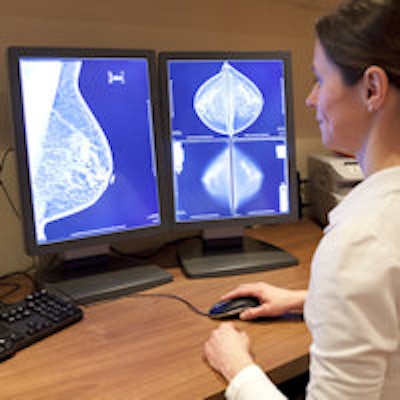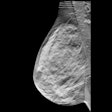
Digital breast tomosynthesis (DBT) reduces recall rates compared with mammography, and this outcome can be maintained over the long term, according to a new study published online in JAMA Oncology.
The findings address one of the key criticisms of breast cancer screening: what some call the "harm" of false-positive exams, which lead to unnecessary recalls, wrote lead author Dr. Elizabeth McDonald, PhD, and colleagues from the University of Pennsylvania.
The researchers examined data from three consecutive years of DBT screening and included analysis of women recalled for screening exams. "We found that reduction in recall was sustainable at a population level, with additional reduction in recall as women returned for a second and third DBT examination," they wrote.
Fewer recalls
McDonald and colleagues retrospectively analyzed screening mammography for all patients who presented for the exam over a four-year period at the University of Pennsylvania, identifying 44,468 screening exams in nearly 24,000 women. DBT was implemented at the university in 2011; for the study, the researchers compared differences in screening outcomes between a year when digital mammography alone was used (2010-2011) and three DBT years (2011 to 2014).
Patients included in the study had no history of breast cancer and no clinical symptoms. Women screened between 2010 and 2011 underwent digital mammography imaging, while those screened after the university began to use DBT technology received both a digital mammography exam and a DBT exam of each breast. Screening volumes were consistent throughout the years included in the study (JAMA Onc, February 18, 2016).
Although the recall rate for the three DBT years rose slightly, it was lower than the rate for digital mammography alone, the researchers found.
In addition, the cancer detection rate increased over the study time frame, the number of cancer cases per recalled patients increased, and the rate of invasive cancers detected remained steady -- although with the exception of DBT years 2 and 3 for the number of cancer cases per recalled patients, only the recall rate improvement was statistically significant.
| Performance of digital mammography and DBT | |||||
| Measures | Digital mammography, year 0 | DBT, year 1 (p-value) |
DBT, year 2 (p-value) |
DBT, year 3 (p-value) |
|
| Recall rate per 1,000 women screened | 104 | 88 (p < 0.0001) | 90 (p = 0.0005) | 92 (p = 0.0025) | |
| Cancer detection rate per 1,000 women screened | 4.6 | 5.5 (p = 0.370) | 5.8 (p = 0.196) | 6.1 (p = 0.110) | |
| PPV1 (number of cancer cases per recalled patients) | 4.4% | 6.2% (p = 0.063) | 6.5% (p = 0.034) | 6.7% (p = 0.020) | |
| Invasive cancers per 1,000 women screened | 3.2 | 3.8 (p = 0.420) | 4.1 (p = 0.243) | 4.1 (p = 0.269) | |
As for interval cancers, the researchers defined them as symptomatic disease that appeared within a year of a negative screening exam. The rate decreased from 0.7 per 1,000 women screened with digital mammography to 0.5 per 1,000 screened with DBT, corresponding author Dr. Emily Conant told AuntMinnie.com.
"The findings show that we continue to learn how to use DBT -- and do better over time," Conant said.
Evidence gaps
Excitement about DBT has prompted clinicians to begin using it even though data have been lacking about its long-term performance, according to an editorial that accompanied the study. In fact, 50% of facilities in the Breast Cancer Surveillance Consortium (BCSC) now offer it, wrote Dr. Nehmat Houssami, PhD, from the University of Sydney and Diana Miglioretti, PhD, from the University of California, Davis.
 Dr. Emily Conant from the University of Pennsylvania.
Dr. Emily Conant from the University of Pennsylvania.But more evidence is needed, the two wrote.
"In this landscape of rapidly emerging evidence on, and enthusiasm for, adjunct DBT screening, there are evidence gaps surrounding its effectiveness, not the least of which is whether adjunct DBT will translate into incremental screening benefit in terms of breast cancer mortality reduction, or whether DBT's additional breast cancer detection merely contributes to overdiagnosis," they wrote.
The study offers new data to fill some evidence gaps, but it does not address the question of whether the technology will enhance screening benefit beyond improving performance measures. The results show a possible small improvement in breast cancer detection in each screening year during which DBT was used; however, these rates did not statistically differ from the digital mammography-only screening year. And the researchers' finding of a decline in interval cancer rates is not convincing, according to Houssami and Miglioretti.
"We need to be cautious about generalizing these results from the University of Pennsylvania to other U.S. practices and to other countries," they concluded.
The study has limitations, McDonald and colleagues conceded. But it does suggest that sustained -- and even improved -- performance is possible with consecutive DBT screening, according to Conant.
"These findings are further evidence that digital breast tomosynthesis is the better mammography exam," she said. "Our results show that positive outcomes can be sustained. It's a good first step toward integrating the technology into population screening programs."




















